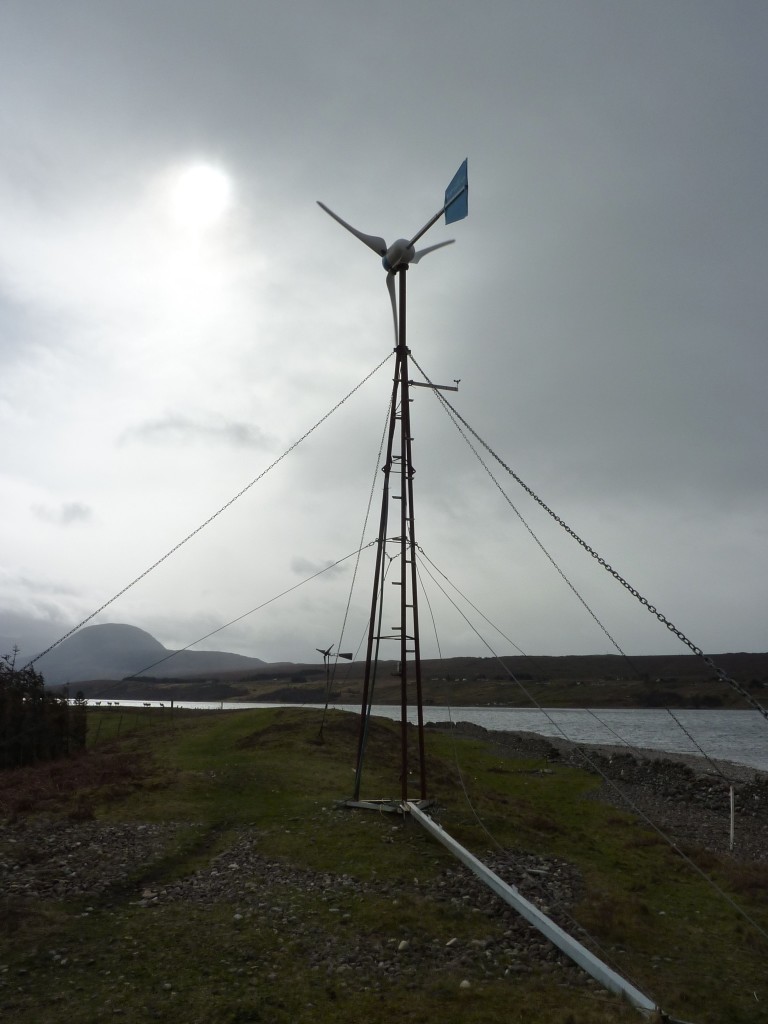An update 2 years on for my post on the Windtracker by Logic energy.
I put one of these windtrackers on a windmill tower (the Kestrel tower actually http://scoraigwind.co.uk/?s=kestrel which is the right hand end one in the above photo) in March 2012, and to be honest I have not bothered to do anything in the interim. So I was a little worried that I would have lost all my data. The logger is still on its original batteries. voltage was 2.5. The LED was still winking gently. And I got the following data off the card for windspeed:
| wind m/s | hours |
| 2 | 4,512 |
| 3 | 2,163 |
| 4 | 2,196 |
| 5 | 1,998 |
| 6 | 1,757 |
| 7 | 1,421 |
| 8 | 1,074 |
| 9 | 876 |
| 10 | 737 |
| 11 | 542 |
| 12 m/s average bin | 329 |
| 13 m/s or over | 467 |
| average windspeed: 5.09 | |
| total hours | 18,072 |
http://shop.logicenergy.com/pages/how-windtracker-report-works
(I did not have a windvane connected but the logger also stores a useful windrose.)
The data is compromised by the fact that the anemometer is mounted on the west side of the tower and we have had a lot of east winds so it will have under-read those winds. But it’s a very useful clue to the site windspeed distribution. Raw data on the card is the number of ten minute intervals for each windspeed bin as a text file.



Yes I’d advise people who are on the grid to use that for a battery rather than have a battery system although there are pros and cons there. HUgh
Some good insight there ,thanks for the reply.I didnt realise the people who payed the subsidy were those without the choice of a tarrif ,doesnt seem to make much sense that one.Wonder if its the same system here.
Looks like battery banks are the best option for microgeneration, unless a willing to pay a lot more for approved equipment.
“the product and the installer “certificated” by the MCS”, seems like the sown up tight approach was used here.
Regards Mattie
Hi,
The approved product (and installer) is only necessary if you’re wanting to get a FIT – it is my understanding that (in the midlands of England at least) one can hook up to the grid with a DIY machine as long as the inverter is G83 approved and the 230V wiring is done/signed off by someone with “Part-P”.
You’ll get no finacial recompense other than bill-savings (~15p/unit in the UK) but you will benefit from the increased output due to MPPT that comes as standard with grid-tie systems.
Since exporting really doesn’t make sense without a FIT (except for the warm-altruist feeling you get!) it only makes sense if you’ve got either a large enough base-load or can switch in heating loads to make use of all your generation on site in real time.
The choice then comes between replacing batteries after ~8 years or an inverter after ~10 years- neither of which are cheap (from a finacial or embodied energy perspective)
More higly useful information.Id allways looked upon the battery banks as the equipment that would need eventual replacement and had not considered the inverters lifetime.
Its the same here with G83 approved units,the MPPT increased output would have to be weighted against the cost of purchasing the inverter.
Thanks for taking the time to reply
Regards Mattie
Looking at the data logger results,thats a nice bit of energy, converting to say a feed in tarrif for Ireland i believe @ .16c/kWh=3642 euro.
The kestrel seems to be a great wind turbine from the other article you have posted.
Have you ever considered how it may be possible for the DIY builder to meet EN 50438 (taken from IWEA website)and make use of the grid and save on battery costs?Or is it even worth looking at?
No idea how i can edit a post ,3564 euro 🙂
hi Mattie,
I doubt if it would be worthwhile for a DIY turbine builder to jump through the hoops to qualify. Here in the UK you need to have both the product and the installer “certificated” by the MCS. This is a lengthy and expensive process, quite disproportionate to the value of any feed in tariffs you would obtain from a single turbine.
I had it explained to me that the tariff is not meant as a subsidy to renewable energy but as a subsidy to setting up a professional industry. I suppose that it has done this to an extent although it has created a very expensive industry that cannot succeed without subsidies.
On a personal level I am not unduly impressed with what the tariff has done to people’s motivation in the field of renewables. I see a lot of folk generating power and throwing it away just for the sake of the subsidy. This money is taken out of the pockets of people who are paying their electricity bills, people without the capital resources to invest in a big renewable energy system themselves. It’s a shame to see them exploited.
I go on making and using renewable energy because i love it and it’s handy that people sometimes pay me for helping them to do it .
Hugh